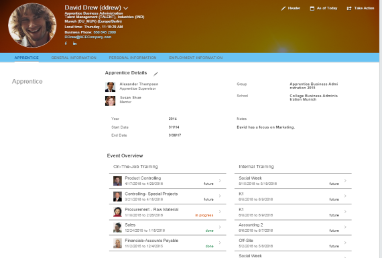SAP SuccessFactors is expanding its definition of total workforce management with the introduction of apprentice management capabilities within its Employee Central solution. This new functionality, part of the first quarterly release of 2016, helps enable your business to organize, manage, engage, and retain the newest members of your workforce while upping the game of your apprenticeship program.

Apprenticeship Program Overview
Findings from the Workforce 2020 study conducted by Oxford Economics and SAP indicate that two of the three top-of-mind issues impacting workforce strategy are millennials entering the workforce and difficulty recruiting employees with base-level skills. Apprenticeship programs in countries such as Germany, France, Austria, Switzerland, and the UK may help address the challenges that companies face finding and retaining a skilled workforce.
According to the International Labour Organization, apprenticeships were created to be an “effective means of bridging” the gap between in-classroom learning and what it means to be a member of the workforce, making it possible for students to gain “work experience along with technical and professional training”.
Business Impact
The war for talent continues to be a source of anxiety for HR departments and organizations. The International Labour Office (ILO) states that apprenticeship programs offer an opportunity to train new workforce entrants according to specific corporate requirements, including both soft and hard skills. As a unique source of the recruiting talent pool, apprentices contribute to workforce productivity. Research from the ILO found that apprentices who were recruited as permanent employees garnered significant return on the participating company’s investment.
Challenges of Apprenticeship Programs
Planning apprenticeships while considering the needs of the talent and the various constraints from the departments and training is fairly complex. Apprentice schedules are split between school and on-the-job training formal corporate training. To further complicate scheduling, the International Chamber of Commerce requires that apprentices rotate on-the-job training between different departments. Several research studies have found apprentices have a high leave-rate; for example a report from the Australian Government’s Department of Industry indicated that half of participants quit by the six month mark. The implications are vast: the high rate of dissatisfaction impacts the participating company’s brand with new talent while diminishing ROI. Additional research indicates that corporations that build in a high level of collaboration, directed marketing and communication, and who provide tools that allow managers to engage with apprentices and allow apprentices to have insights into their schedules and output expectations have a higher likelihood of long-term success and ROI.

Apprentice Management Capabilities in SAP SuccessFactors Employee Central Core HR
SAP SuccessFactors Employee Central apprentice management capabilities provide the support, self-management, and engagement mechanisms that help the ongoing relationships between apprentices, apprentice program managers, and on-site supervisors. With SAP SuccessFactors Employee Central:
- Apprentice supervisors are able to efficiently and effectively manage these programs for compliance and operational needs. They are able to easily share the apprentice plans and schedules with on-site supervisors and apprentices.
- On-site supervisors are able to manage the needs of their departments holistically. Our solution provides a total view into department plans while enabling key insights needed on individual apprentices in order to lead teams to productivity.
- Apprentices can easily access their individual plans for work and study, providing much needed visibility into their schedules and enabling ownership and clarity over their work experience.









